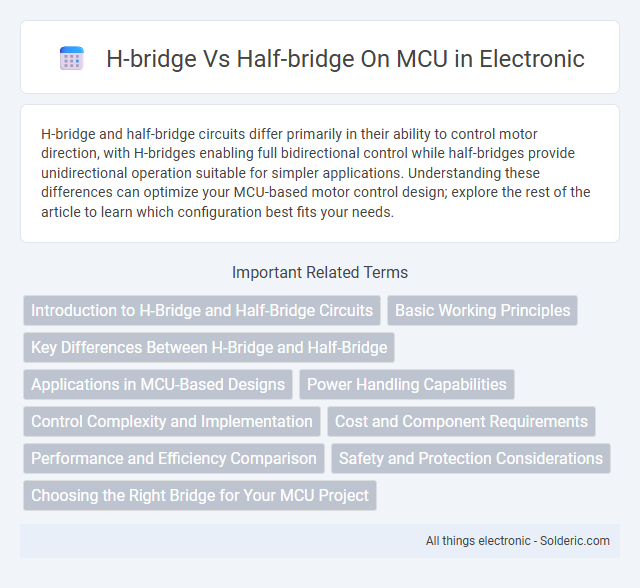H-bridge and half-bridge circuits differ primarily in their ability to control motor direction, with H-bridges enabling full bidirectional control while half-bridges provide unidirectional operation suitable for simpler applications. Understanding these differences can optimize your MCU-based motor control design; explore the rest of the article to learn which configuration best fits your needs.
Comparison Table
| Feature | H-Bridge | Half-Bridge |
|---|---|---|
| Application | Bidirectional motor control, full bridge inverter | Single-phase inverter, motor driver phase control |
| Number of Switches | 4 switches (transistors or MOSFETs) | 2 switches (high-side and low-side) |
| Direction Control | Yes, supports forward and reverse | No, controls only one half of the load |
| Complexity | Higher complexity, requires careful dead-time management | Lower complexity, simpler PWM control |
| Cost | Higher due to more components | Lower with fewer components |
| MCU Interface | Requires multiple PWM signals and tight synchronization | Requires fewer PWM channels, simpler interface |
| Use Case Example | DC motor bidirectional speed control in robotics | DC motor speed control with single direction or half inverter in power supplies |
Introduction to H-Bridge and Half-Bridge Circuits
H-Bridge and Half-Bridge circuits are essential components in motor control applications using microcontroller units (MCUs), enabling precise direction and speed management of DC motors. An H-Bridge consists of four switches arranged in a configuration to allow current flow in both directions, providing full bidirectional control, while a Half-Bridge uses two switches to control the current flow in a single direction or phase. Your choice between the two depends on the complexity of the motor control task, with H-Bridges suitable for full DC motor control and Half-Bridges often used in simpler or multi-phase inverter applications.
Basic Working Principles
An H-bridge on an MCU uses four switches arranged in a bridge configuration to control the direction of current through a load, enabling bidirectional motor control. A Half-bridge employs two switches connected in series with the load, allowing for simpler control but limited to unidirectional current flow or voltage output. Both configurations utilize Pulse Width Modulation (PWM) signals from the MCU to efficiently regulate power delivery and motor speed.
Key Differences Between H-Bridge and Half-Bridge
An H-bridge consists of four switches arranged to control the direction of current through a load, enabling bidirectional control of DC motors, while a half-bridge uses only two switches and typically handles unidirectional current flow. H-bridges offer complete motor control with forward, reverse, brake, and coast functions, whereas half-bridges are mainly for simpler applications like driving a single transistor or part of a full bridge configuration. In microcontroller-based motor control, H-bridges provide greater versatility and complexity, whereas half-bridges are more efficient for lower power or single-ended switching tasks.
Applications in MCU-Based Designs
H-bridge circuits in MCU-based designs enable precise bidirectional control of DC motors, making them ideal for robotics and motor driver applications where full reversing capability is essential. Half-bridge configurations are commonly used for driving inductive loads such as solenoids or as power stages in Class D amplifiers, benefiting from simpler control and reduced component count. Your choice between H-bridge and half-bridge depends on the required load control complexity and power handling in the MCU application.
Power Handling Capabilities
H-bridges offer superior power handling capabilities compared to half-bridges, making them ideal for driving DC motors with bidirectional control and higher current demands. Half-bridges handle moderate power levels, suitable for single-phase motor control or power supply regulation, but may struggle with higher voltage and current loads. Your choice depends on the power requirements and complexity of the motor control application on your MCU platform.
Control Complexity and Implementation
H-bridge configurations offer full control over motor direction and speed, requiring more complex PWM signal management and additional GPIO pins on your MCU for precise bidirectional control. Half-bridge circuits simplify implementation with fewer components and less control complexity, typically used for unidirectional motor control or power stages in DC-DC converters. Efficiently balancing your MCU's pin availability and software overhead is crucial when choosing between H-bridge and half-bridge topologies for your application.
Cost and Component Requirements
H-bridge configurations for MCUs typically incur higher costs due to the increased number of components, such as four transistors and additional gate drivers, compared to half-bridge designs that require only two transistors. The half-bridge approach reduces complexity and component count, lowering both assembly time and overall expense, making it ideal for simpler motor control applications. Your choice between H-bridge and half-bridge should consider these cost and component trade-offs alongside functional requirements.
Performance and Efficiency Comparison
H-bridge circuits offer superior bidirectional motor control with high efficiency due to their ability to drive motors in both forward and reverse directions, making them ideal for full-cycle operations in microcontroller units (MCUs). Half-bridge configurations provide simpler design and lower component count, resulting in reduced power losses and efficient performance in unidirectional switching applications. Performance-wise, H-bridges consume more power under heavy load but deliver greater versatility, whereas half-bridges excel in efficiency for tasks requiring rapid switching and lower current demands.
Safety and Protection Considerations
H-bridge configurations in MCUs offer enhanced safety by allowing bidirectional control and rapid fault detection to prevent damage from short circuits and overcurrent conditions. Half-bridge designs provide basic protection with fewer components but may require external circuitry for comprehensive fault management and thermal shutdown. Ensuring your MCU's drive circuitry includes built-in undervoltage lockout and overcurrent protection features significantly improves system reliability and safeguards connected loads.
Choosing the Right Bridge for Your MCU Project
Choosing the right bridge for your MCU project depends on your power requirements and control complexity. An H-bridge provides full bidirectional control of a DC motor, enabling precise speed and direction manipulation, ideal for applications requiring motor reversal or regenerative braking. A half-bridge, while simpler and less costly, is suited for unidirectional loads or high-frequency switching tasks where full polarity control isn't necessary.
H-bridge vs Half-bridge on MCU Infographic

 solderic.com
solderic.com